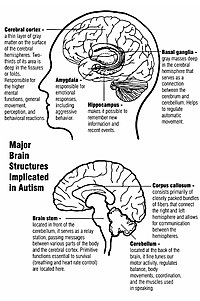
Photo from wikipedia
We sought to estimate the prevalence of autism spectrum disorder (ASD) in children born extremely preterm relative to the U.S. population risk of 1.5% [CDC, 2014] using the best‐available diagnostic… Click to show full abstract
We sought to estimate the prevalence of autism spectrum disorder (ASD) in children born extremely preterm relative to the U.S. population risk of 1.5% [CDC, 2014] using the best‐available diagnostic procedures and minimizing confounding with other neurodevelopmental impairments. Eight hundred and eighty nine of 966 (92%) 10‐year‐old children from the Extremely Low Gestational Age Newborn birth cohort, delivered at 23–27 weeks gestation in 2002–2004, participated. Children meeting ASD screening criteria on the Social Communication Questionnaire were evaluated with the Autism Diagnostic Interview–Revised (ADI‐R). Those meeting ADI‐R criteria were assessed with the Autism Diagnostic Observation Schedule‐2 (ADOS‐2). A positive ADOS‐2 score was the criterion for ASD. Twenty‐six participants were not assessed for ASD because of severe sensory or motor impairment. In the remaining sample, 61 children met criteria for ASD, resulting in a prevalence of 7.1% (95% CI = 5.5–9.0). ASD risk decreased with increasing gestational age, from 15.0% (95% CI = 10.0–21.2) for 23–24 weeks, 6.5% (95% CI = 4.2–9.4) for 25–26 weeks, to 3.4% (95% CI = 1.6–6.1) for 27 weeks gestational age, and this association was independent of IQ. Among children with ASD, 40% had intellectual disability. The male‐to‐female ratio of children with ASD was 2.1:1 (95% CI = 1.2:1–3.5:1), lower than in the general population (4:1). ASD prevalence in the ELGAN cohort was four times higher than in the general population, and was strongly associated with gestational age, underscoring the need for enhanced ASD screening of children born preterm, and suggesting that some risk factors associated with preterm birth may also play a role in the etiology of autism. Autism Res 2017, 10: 224–232. © 2016 International Society for Autism Research, Wiley Periodicals, Inc.
Journal Title: Autism Research
Year Published: 2017
Link to full text (if available)
Share on Social Media: Sign Up to like & get
recommendations!